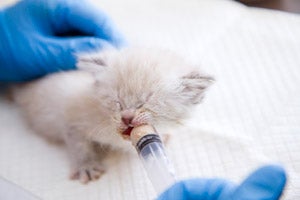How to care for orphaned kittens: Feeding and weaning motherless kittens

Feeding orphaned kittens can feel like a full-time job, especially in the beginning when they need to be fed the most. But it’s also incredibly rewarding, and before you know it, your kittens will be eating on their own and soon ready to find homes. The feeding protocols below are provided by the Kitten Nursery of Salt Lake County Animal Services, in partnership with Best Friends Animal Society–Utah.
 Kittens one week old or less: Bottle-feeding
Kittens one week old or less: Bottle-feeding
- Food type: Formula
- Frequency: Every 2 – 3 hours (8 – 12 times per day)
- Amount: 3 – 4 cc per feeding
Two-week-old kittens: Bottle-feeding
- Food type: Formula
- Frequency: Every 3 hours (8 times per day)
- Amount: 5 – 6 cc per feeding
Three- to four-week-old kittens: Bottle-feeding
- Food type: Formula
- Frequency: Every 4 hours (6 times per day)
- Amount: 13 – 17 cc per feeding
Four-week-old kittens: Begin feeding gruel – Weaning stage
- Food type: 1/2 can per kitten of gruel (gruel instructions below) in a dish and dry kitten food in a dish, and dish full of water at all times. Plus formula three times per day.
- Frequency: Keep kibble, water and gruel in cage at all times.
- Give 13 – 17 cc of formula every 8 hours (3 times per day).
- During bottle-feeding sessions, try to get the kittens to also eat gruel off a spoon or tongue depressor and from a dish (see instructions on making gruel for more tips). It is important to start getting small amounts of gruel into their stomachs.
- Note: At this time, also introduce litter box; kittens can eliminate on their own at this age and do not need to be stimulated to go anymore.
How to mix gruel
Small batch (for one kitten): ½ can of wet kitten food mixed with ¼ can of formula (use an empty food can as a measuring cup).
Large batch: Whisk 8 cans wet kitten food with 4 cans of fresh, warm formula (use the empty food can as a measuring cup). At this age, kittens like their food a little lumpy so they can chew.
Note: Substitute the warm water for formula in gruel for kittens 5 weeks and older.
Helpful tips when using gruel:
- When introducing kittens to gruel, put gruel in a flat dish and place kittens near the dish. If they do not start to eat on their own after a few minutes, use tongue depressor or spoon to scoop gruel into kitten’s mouth. You may have to open their mouth and put a little in. You can also put a little gruel on their nose and see if they will lick it off. Sometimes the kittens need to adjust to the new taste.
- Once kitten starts to eat gruel off the spoon or tongue depressor (may take a few feedings for them to figure this step out), slowly start to lower it towards the dish of gruel. The kittens should easily transition from the spoon or depressor to the dish (may take a day for them to start eating out of the dish regularly).
- During the weaning process, kittens still need to be bottle-fed three times per day (about every 8 hours) to ensure they are receiving proper nutrients.
Five- to eight-week-old kittens: Solid food
Food type: ½ can per kitten of kibble in a dish and wet food in a dish at all times, and a dish full of water at all times
- Kittens 3 to 5 weeks should be given baby cat kibble.
- Kittens 5 to 6 weeks should be given kitten kibble and kibble should be mixed into the wet food.
- Kittens 7 weeks and older should eat mainly dry kibble.
- Weeks 5 and 6 are transition weeks where the two foods (what they were eating and what they will be eating) should be mixed together so their tummies do not get upset by the change in diet. Gradually decrease the amount of food they were eating while increasing what they will be eating over the course of 7 days.
Spay or neuter and adoption
 Eight-week-old healthy kittens are fully weaned and should soon be ready to be spayed or neutered and to find their new forever homes. It is much easier to find homes for eight-week old kittens than it is if you wait longer, so start setting a plan early on. Sharing photos of the kittens with friends and family as they grow, and telling everyone you know that you’ll be looking for homes for the kittens is a great way to find homes. For more advice on finding homes for the kittens, see this guide on finding homes for homeless pets.
Eight-week-old healthy kittens are fully weaned and should soon be ready to be spayed or neutered and to find their new forever homes. It is much easier to find homes for eight-week old kittens than it is if you wait longer, so start setting a plan early on. Sharing photos of the kittens with friends and family as they grow, and telling everyone you know that you’ll be looking for homes for the kittens is a great way to find homes. For more advice on finding homes for the kittens, see this guide on finding homes for homeless pets.
It is also important to ensure that all the kittens are spayed or neutered, so they don’t accidentally add to the thousands of unplanned litters of kittens that enter shelters each year. Find a low-cost spay/neuter clinic near you.
While caring for orphaned kittens is a lot of work, it’s also a lot of fun. The most rewarding part is watching your charges grow up and go into new homes. And the best part is that you can feel good knowing that you helped keep kittens — the most at-risk animals to enter shelters — safe and sound.
More about abandoned baby kitten care
Note: This article is the last in a four-part series on caring for baby kittens who are abandoned.
Photos by Sarah Ause Kichas